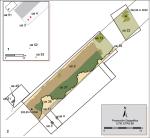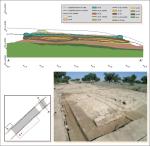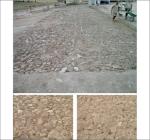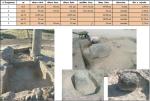Summary (English)
The area excavated in September and October 2010 is located in the Archaeological Zone V, of general protection, so the archaeological works, commissioned by the Alba Plata Management Office of the Regional Government of Extremadura began with a survey. The archaeologist C. Pérez accepted the commission and then drafted an excavation project, approved by Alba Plata and developed by the Consorcio de la Ciudad Monumental. According to the original project, an area of 245 m2 in the intersection of Vía de la Plata (inside the Casa de Campo) and the access road from Mirandilla was to be excavated. Later, the initial cut was extended 2 m on its northwestern side until it reached the end of the road, which was outside its original route. Although it was not included in the original project, a second cut measuring 8 × 5 m was also made to the northeast of the first one, over a space through which the estate’s firebreak ran. In addition, a last cut measuring 3.10 × 5.65 m was made in the NW corner, extending the first one. A fragment of a milestone was there found, displaced from its original location, but the purpose was also the observation of the drainage system of the road and the existing stratigraphy.
This road, which starts at the North of Mérida, had already been excavated in different sections after the Barraeca bridge. The documented area corresponds to a small section of the so-called iter ab Emerita Caesaraugustam Roman road. As an aerial photography shows the road after crossing the wall of the Roman city takes a northeastern orientation, the same as the bridge over the _Barraeca river, creating a straight line from the wall which turns towards the east in the area of the section now excavated.
The section of the Roman road affected by this intervention is 45 m in length with 34 m already documented. Its width varies, depending on the area, between 6.55 and 6.20 m and there is a slight elevation of the road towards the northeast. Originally, the work area was limited to the complete width of the road, documenting the state of the upper layers as they had been preserved without removing any archaeological strata from the road, which limited the potential of documentation. However, we have observed that this section is composed of an alternating succession of narrow and regular earthen strata laid on top of the natural rock. The lower and initial stratum was a layer of earth that levelled out the irregularities of the rock. The overlaying layer of stones had lateral kerbs and an alignment of larger stones in the centre from which some peaks emerged in the second layer. On the outside, especially on the northern side of the road, a layer with a descending surface towards the kerbs is preserved, a kind of ‘ditch’ that facilitated the evacuation of water.
The archaeological intervention concluded with the study of several milestones, all made of granite. Of the 5 fragments found (4 to the southeast and 1 to the northwest) only one was in situ; the only one preserved virtually complete. Of the other 4, there are 2 fragments of the shaft and another 2 that also included the base. This accumulation is not strange, since at some point on this same roadway there are up to 9 milestones preserved, which are undoubtedly related to the repairs.
Archaeological materials recovered in the excavation were very scarce and come from strata after the construction of the road, which provides little chronological information.
(translation by Himar González González)
- Teresa Barrientos Vera
Director
- Teresa Barrientos Vera (Consorcio Ciudad Monumental de Mérida)
Team
- Francisco Isidoro
- Javier Pacheco
- Vicente Collado, Natalio Heredia, Ma del Mar Ledo, Francisco Llanos, Ángel Reyes y Antonio Sánchez
Research Body
- Consorcio Ciudad Monumental de Mérida
Funding Body
- Oficina Alba Plata (Junta de Extremadura)






![Download [PDF]](/excavation/skins/fasti/images/results/download_sml.png)



